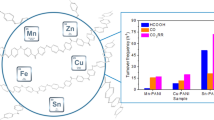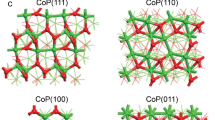Abstract
A facile synthetic pathway using poly(4-vinylpyridine) as a polypyridyl platform is reported for the formation of a metallopolymer. Electrochemical studies indicate that the metallopolymer acts as an efficient H2 evolution catalyst similar to cobalt polypyridyl complexes. It is also observed that the metallopolymer is transformed to cobalt particles when a cathodic potential is applied in the presence of an acid. Electrochemical measurements indicate that an FTO electrode coated with these cobalt particles also acts as an efficient hydrogen evolution catalyst. Approximately 80 µmoles of H2 gas can be collected during 2 h of electrolysis at − 1.5 V (vs. Fc+/0) in the presence of 60 mM of acetic acid. A comprehensive study of the electrochemical and electrocatalytic behavior of cobalt–poly(4-vinylpyridine) is discussed in detail.
Graphical Abstract
Poly(4-vinylpyridine) as a precursor for electrodeposited cobalt particles: a cobalt coat derived by a metallopolymer acts as an efficient H2 evolution catalyst. It can transform to a cobalt coat when a potential above − 1.1 V is applied in acid medium. Exchange current density of 10−2.67 mA cm−2 was observed from the Co-coat at − 1.5 V (vs. Fc+/0).






Similar content being viewed by others
References
Helm ML, Stewart MP, Bullock RM et al (2011) A synthetic nickel electrocatalyst with a turnover frequency above 100,000 s−1 for H2 production. Science 333:863–866
Zee DZ, Chantarojsiri T, Long JR, Chang CJ (2015) Metal-polypyridyl catalysts for electro- and photochemical reduction of water to hydrogen. Acc Chem Res 48:2027–2036. https://doi.org/10.1021/acs.accounts.5b00082
Eckenhoff WT, McNamara WR, Du P, Eisenberg R (2013) Cobalt complexes as artificial hydrogenases for the reductive side of water splitting. Biochim Biophys Acta 1827:958–973. https://doi.org/10.1016/j.bbabio.2013.05.003
McKone JR, Marinescu SC, Brunschwig BS et al (2014) Earth-abundant hydrogen evolution electrocatalysts. Chem Sci 5:865–878. https://doi.org/10.1039/C3SC51711J
Losse S, Vos JG, Rau S (2010) Catalytic hydrogen production at cobalt centres. Coord Chem Rev 254:2492–2504. https://doi.org/10.1016/j.ccr.2010.06.004
Du P, Eisenberg R (2012) Catalysts made of earth-abundant elements (Co, Ni, Fe) for water splitting: recent progress and future challenges. Energy Environ Sci 5:6012. https://doi.org/10.1039/c2ee03250c
Queyriaux N, Jane RT, Massin J et al (2015) Recent developments in hydrogen evolving molecular cobalt(II)-polypyridyl catalysts. Coord Chem Rev 304–305:3–19. https://doi.org/10.1016/j.ccr.2015.03.014
Dempsey JL, Brunschwig BS, Winkler JR, Gray HB (2009) Hydrogen evolution catalyzed by cobaloximes. Acc Chem Res 42:1995–2004. https://doi.org/10.1021/ar900253e
Razavet M, Artero V, Fontecave M (2005) Proton electroreduction catalyzed by cobaloximes: functional models for hydrogenases. Inorg Chem 44:4786–4795. https://doi.org/10.1021/ic050167z
Reuillard B, Warnan J, Leung JJ et al (2016) A poly(cobaloxime)/carbon nanotube electrode: freestanding buckypaper with polymer-enhanced H2-evolution performance. Angew Chem Int Ed 55:3952–3957. https://doi.org/10.1002/anie.201511378
Kaeffer N, Chavarot-Kerlidou M, Artero V (2015) Hydrogen evolution catalyzed by cobalt diimine-dioxime complexes. Acc Chem Res 48:1286–1295. https://doi.org/10.1021/acs.accounts.5b00058
Khnayzer RS, Thoi VS, Nippe M et al (2014) Towards a comprehensive understanding of visible-light photogeneration of hydrogen from water using cobalt(ii) polypyridyl catalysts. Energy Environ Sci 7:1477. https://doi.org/10.1039/c3ee43982h
Rodenberg A, Orazietti M, Probst B et al (2015) Mechanism of photocatalytic hydrogen generation by a polypyridyl-based cobalt catalyst in aqueous solution. Inorg Chem 54:646–657. https://doi.org/10.1021/ic502591a
Vennampalli M, Liang G, Katta L et al (2014) Electronic effects on a mononuclear Co complex with a pentadentate ligand for catalytic H2 evolution. Inorg Chem 53:10094–10100. https://doi.org/10.1021/ic500840e
Yang JY, Bullock RM, DuBois MR, DuBois DL (2011) Fast and efficient molecular electrocatalysts for H2 production: using hydrogenase enzymes as guides. MRS Bull 36:39–47. https://doi.org/10.1557/mrs.2010.8
Pool DH, DuBois DL (2009) [Ni(PPh2NAr2)2(NCMe)][BF4]2 as an electrocatalyst for H2 production: PPh2NAr2 = 1,5-(di(4-(thiophene-3-yl)phenyl)-3,7-diphenyl-1,5-diaza-3,7-diphosphacyclooctane). J Organomet Chem 694:2858–2865. https://doi.org/10.1016/j.jorganchem.2009.04.010
Seo J, Pekarek RT, Rose MJ (2015) Photoelectrochemical operation of a surface-bound, nickel-phosphine H2 evolution catalyst on p-Si(111): a molecular semiconductor catalyst construct. Chem Commun 51:4–7. https://doi.org/10.1039/C5CC02802G
Sun Y, Liu C, Grauer DC et al (2013) Electrodeposited cobalt-sulfide catalyst for electrochemical and photoelectrochemical hydrogen generation from water. J Am Chem Soc 135:17699–17702. https://doi.org/10.1021/ja4094764
Kaeffer N, Morozan A, Fize J et al (2016) The dark side of molecular catalysis: diimine-dioxime cobalt complexes are not the actual hydrogen evolution electrocatalyst in acidic aqueous solutions. ACS Catal 6:3727–3737. https://doi.org/10.1021/acscatal.6b00378
Anxolabéhère-Mallart E, Costentin C, Fournier M et al (2012) Boron-capped tris(glyoximato) cobalt clathrochelate as a precursor for the electrodeposition of nanoparticles catalyzing H2 evolution in water. J Am Chem Soc 134:6104–6107. https://doi.org/10.1021/ja301134e
El Ghachtouli S, Fournier M, Cherdo S et al (2013) Monometallic cobalt-trisglyoximato complexes as precatalysts for catalytic H2 evolution in water. J Phys Chem C 117:17073–17077. https://doi.org/10.1021/jp405134a
Anxolabéhère-Mallart E, Costentin C, Fournier M, Robert M (2014) Cobalt-bisglyoximato diphenyl complex as a precatalyst for electrocatalytic H2 evolution. J Phys Chem C 118:13377–13381. https://doi.org/10.1021/jp500813r
El Ghachtouli S, Guillot R, Brisset F, Aukauloo A (2013) Cobalt-based particles formed upon electrocatalytic hydrogen production by a cobalt pyridine oxime complex. ChemSusChem 6:2226–2230. https://doi.org/10.1002/cssc.201300564
Martin DJ, McCarthy BD, Donley CL, Dempsey JL (2014) Electrochemical hydrogenation of a homogeneous nickel complex to form a surface adsorbed hydrogen-evolving species. Chem Commun 51:2–5. https://doi.org/10.1039/c4cc08662g
Katoh T, Imamura G, Obata S, Saiki K (2016) Growth of N-doped graphene from nitrogen containing aromatic compounds: the effect of precursors on the doped site. RSC Adv 6:13392–13398. https://doi.org/10.1039/C5RA22664C
Mulyana Y, Alley KG, Davies KM et al (2014) Dinuclear cobalt(II) and cobalt(III) complexes of bis-bidentate napthoquinone ligands. Dalton Trans 43:2499–2511. https://doi.org/10.1039/C3DT52811A
Call A, Codolà Z, Acuña-Parés F, Lloret-Fillol J (2014) Photo- and electrocatalytic H2 production by new first-row transition-metal complexes based on an aminopyridine pentadentate ligand. Chem A Eur J 20:6171–6183. https://doi.org/10.1002/chem.201303317
Fourmond V, Jacques P-A, Fontecave M, Artero V (2010) H2 evolution and molecular electrocatalysts: determination of overpotentials and effect of homoconjugation. Inorg Chem 49:10338–10347. https://doi.org/10.1021/ic101187v
Ahn HS, Davenport TC, Tilley TD (2014) Molecular cobalt electrocatalyst for proton reduction at low overpotential. Chem Commun 50:3834–3837. https://doi.org/10.1039/c3cc49682a
Wilson AD, Newell RH, McNevin MJ et al (2006) Hydrogen oxidation and production using nickel-based molecular catalysts with positioned proton relays. J Am Chem Soc 128:358–366. https://doi.org/10.1021/ja056442y
Bigi JP, Hanna TE, Harman WH et al (2010) Electrocatalytic reduction of protons to hydrogen by a water-compatible cobalt polypyridyl platform. Chem Commun 46:958–960. https://doi.org/10.1039/B915846D
Lin C-N, Zhou L-L, Fu L-Z et al (2015) Synthesis, structure and electrochemical properties of a cobalt(II) complex supported by 2-tetrahydrofurfurylamino-N,N-bis(2-methylene-4-tert-butyl-6-methyl)phenol. INOCHE 61:97–99. https://doi.org/10.1016/j.inoche.2015.08.017
MacDonald L, McGlynn JC, Irvine N et al (2017) Using earth abundant materials for the catalytic evolution of hydrogen from electron-coupled proton buffers. Sustain Energy Fuels 1:1782–1787. https://doi.org/10.1039/C7SE00334J
Jurss JW, Concepcion JC, Norris MR et al (2010) Surface catalysis of water oxidation by the blue ruthenium dimer. Inorg Chem 49:3980–3982. https://doi.org/10.1021/ic100469x
McCrory CCL, Uyeda C, Peters JC (2012) Electrocatalytic hydrogen evolution in acidic water with molecular cobalt tetraazamacrocycles. J Am Chem Soc 134:3164–3170. https://doi.org/10.1021/ja210661k
Masa J, Weide P, Peeters D et al (2016) Amorphous cobalt boride (Co2B) as a highly efficient nonprecious catalyst for electrochemical water splitting: oxygen and hydrogen evolution. Adv Energy Mater 6:1502313. https://doi.org/10.1002/aenm.201502313
Liu X, Zheng H, Sun Z et al (2015) Earth-abundant copper-based bifunctional electrocatalyst for both catalytic hydrogen production and water oxidation. ACS Catal 5:1530–1538. https://doi.org/10.1021/cs501480s
Zeng K, Zhang D (2010) Recent progress in alkaline water electrolysis for hydrogen production and applications. Prog Energy Combust Sci 36:307–326. https://doi.org/10.1016/j.pecs.2009.11.002
Faber MS, Jin S (2014) Earth-abundant inorganic electrocatalysts and their nanostructures for energy conversion applications. Energy Environ Sci 7:3519–3542. https://doi.org/10.1039/C4EE01760A
Cobo S, Heidkamp J, Jacques P-A et al (2012) A Janus cobalt-based catalytic material for electro-splitting of water. Nat Mater 11:802–807. https://doi.org/10.1038/nmat3385
Rioual S, Lescop B, Quentel F, Gloaguen F (2015) A molecular material based on electropolymerized cobalt macrocycles for electrocatalytic hydrogen evolution. Phys Chem Chem Phys 17:13374–13379. https://doi.org/10.1039/C5CP01210D
Mclntyre NS, Cook MG (1975) X-ray photoelectron studies on some oxides and hydroxides of cobalt, nickel, and copper. Anal Chem 47:2208–2213. https://doi.org/10.1021/ac60363a034
Acknowledgements
The authors thank the Science and Technology Council of Turkey, TUBITAK (Project No: 215Z249) for financial support. Emine Ülker thanks TUBITAK for support (Project No: 1929B011500059).
Author information
Authors and Affiliations
Corresponding authors
Electronic supplementary material
Below is the link to the electronic supplementary material.
Rights and permissions
About this article
Cite this article
Kap, Z., Ülker, E., Nune, S.V.K. et al. Electrocatalytic hydrogen evolution with cobalt–poly(4-vinylpyridine) metallopolymers. J Appl Electrochem 48, 201–209 (2018). https://doi.org/10.1007/s10800-018-1152-z
Received:
Accepted:
Published:
Issue Date:
DOI: https://doi.org/10.1007/s10800-018-1152-z




